Strive these extremely gentle and fluffy bread rolls that are scrumptious served with a candy or savoury filling. Recipe for Milk Buns with step-by-step images.

Japanese Milk Buns
If you’re searching for the softest, fluffiest and tastiest bread rolls, look no additional than these Japanese Milk Buns! These are the proper buns for making sandwiches, hamburgers, or to only eat as they’re.
Milk Bun Recipe
This Milk Bun recipe is similar as that which I take advantage of for Japanese Milk Bread Loaf or Shokupan. In reality, it’s a recipe I flip to very ceaselessly at any time when I wish to make very moist, gentle and fluffy bread, regardless of the kind.
To make Milk Buns, I divide the dough to make 9 buns which I bake in a sq. baking pan. Baking them in a high-sided baking pan helps to create tall buns, which suggests a extra gentle and fluffy inside.
What’s Japanese Milk Bread?
- Japanese Milk Bread incorporates milk so as to add a little bit of sweetness and richness to the dough.
- The style and texture is kind of much like a French brioche, however with much less butter.
- Making a Japanese Milk Bread is like making an enriched dough, however with the addition of a paste or starter known as a Yudane or Tangzhong.
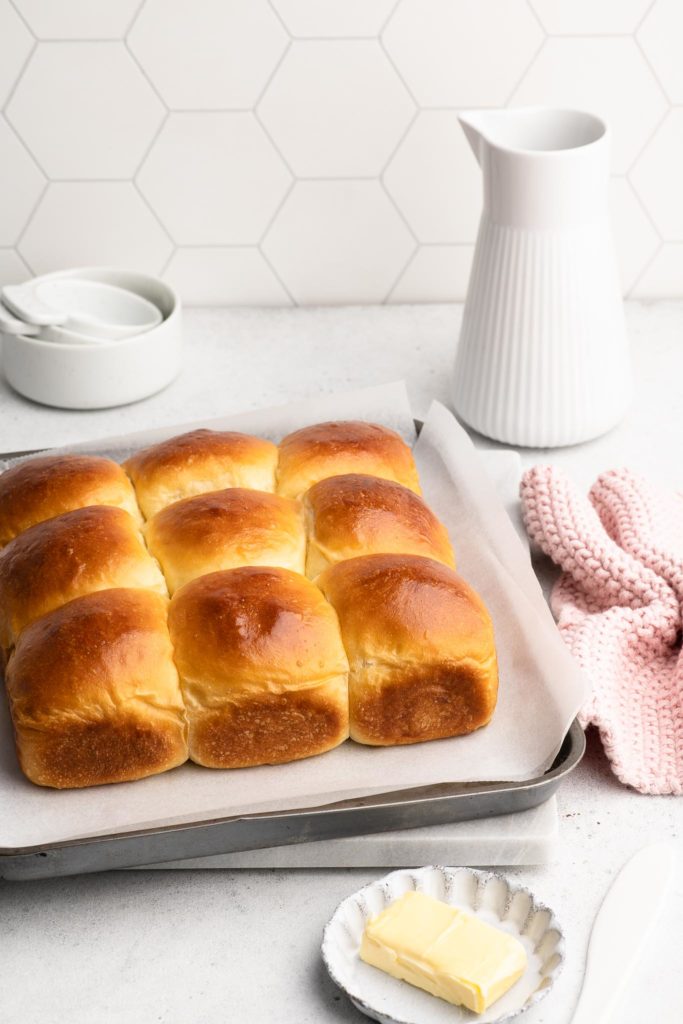
Yudane or Tangzhong
When making milk buns, you both have to make a Yudane or Tangzhong. Each names discuss with a paste or roux comprised of flour and a scorching liquid (both water and/or milk).
The cooled paste is blended into an in any other case frequent enriched bread dough, however as a result of the paste has a excessive liquid content material, it provides moisture to the dough, which creates extra air pockets within the dough, which in flip ends in a gentle and fluffy bread.
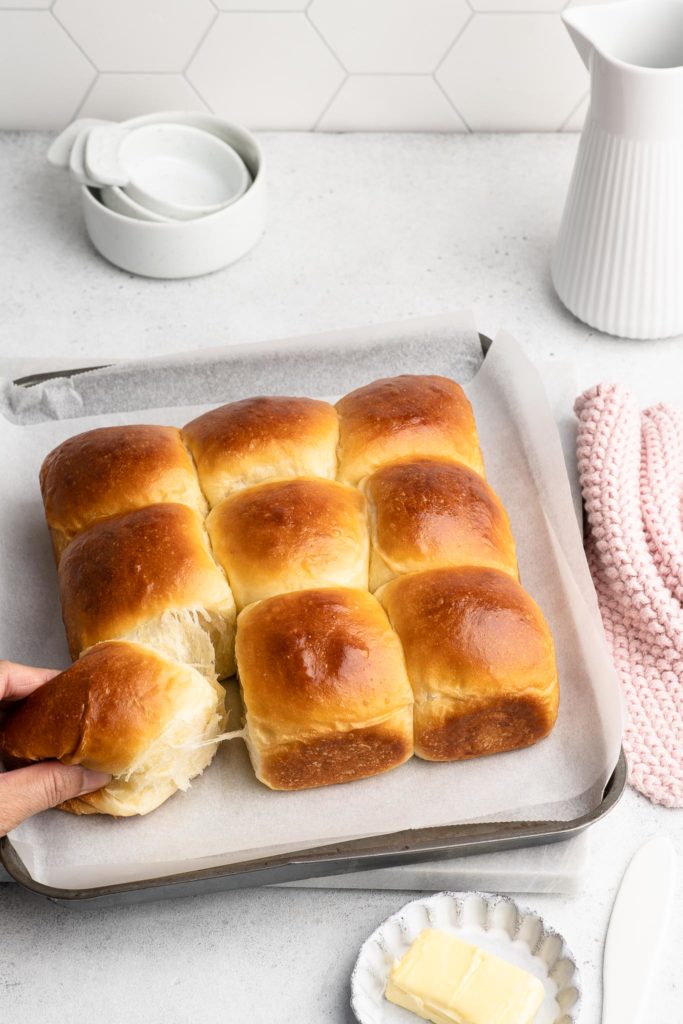
What to Eat with Milk Buns
Milk Buns are primarily very gentle bread rolls. You should use Milk Buns wherever your would use strange white bread rolls, reminiscent of:
- One of the best dinner rolls ever
- Sandwiches
- Hamburgers or Cheeseburgers
- Served plain, or with butter and jam, reminiscent of at breakfast
I favor Milk Buns to Brioche buns as a result of they’re much less wealthy and buttery, which suggests they usually work higher with different accompaniments, whether or not candy or savoury. Brioche, however, is one thing I favor to eat as a candy bread or a dessert.
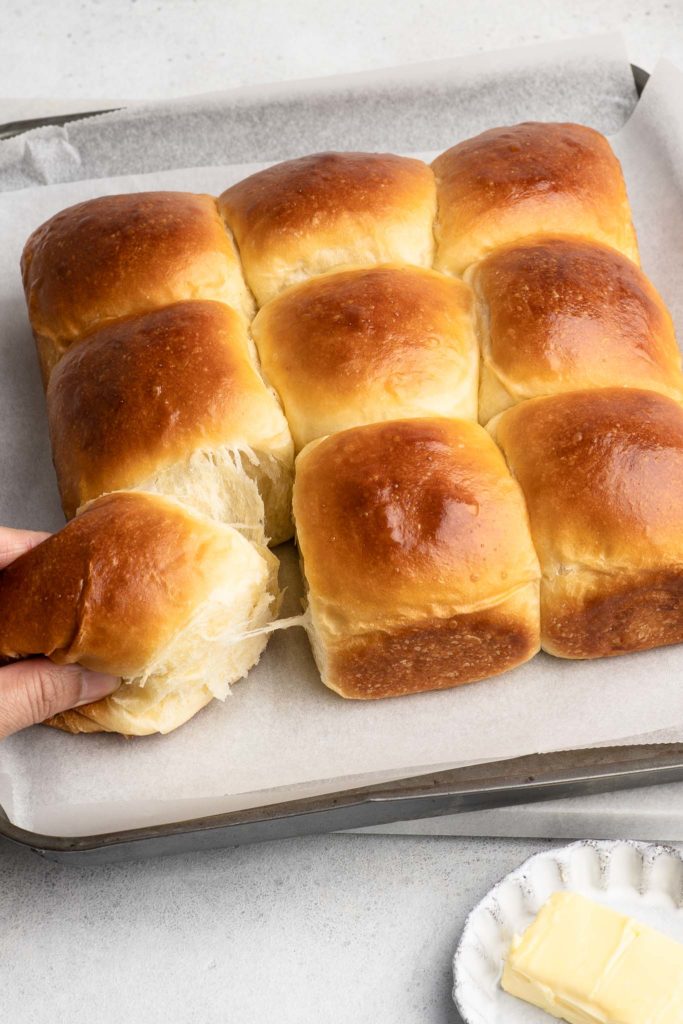
Make Milk Buns
Making a Japanese Milk Buns is similar to making every other loaf of bread, besides that you simply additionally add a floury paste to the dough. This paste, known as a Yudane or Tangzhong, takes just a few minutes to make, however it makes all of the distinction to the completed loaf of bread.
When you get began, you’ll shortly see that this milk bread recipe is kind of much like a brioche recipe, each when it comes to substances, in addition to texture of the dough.
Step 1
Make the Tangzhong by whisking collectively the substances in a small saucepan. Place the saucepan over low warmth, and proceed whisking till the combination kinds a thick paste. You need a thick sufficient consistency in order that, as you whisk the combination, the whisk leaves strains which don’t transfer.
Scrape the Tangzhong right into a small bowl and set it apart to chill. As soon as cooled, cowl the bowl with clingfilm and place it within the fridge in a single day.
If you’re in a rush, you should use the Tangzhong as quickly because it has cooled to room temperature. However leaving the Tangzhong in a single day permits it to develop extra flavour.
Step 2
Measure the flour, yeast, salt and sugar into the bowl of an electrical stand mixer. Frivolously combine the substances collectively.


Step 3
Add the egg and Tangzhong. Use the dough hook to begin to incorporate all the things collectively. Slowly add the milk till a sticky dough begins to kind. Then add the butter, one tablespoon at a time.
Step 4
Knead the dough on medium pace for 10-Quarter-hour till you could have a dough which passes the windowpane check.
To carry out the “windowpane check”, pinch off a small piece of dough, roll it right into a ball and use your palms to softly stretch the dough. If the dough can stretch to kind a skinny sheet and be virtually translucent with the intention to see the sunshine by it, your dough has handed the “windowpane check”. Which means that you could have kneaded the dough sufficiently and that the dough is able to be proofed.
At this stage, the dough will likely be considerably sticky and cheesy, largely due to the butter and excessive liquid content material. However the dough ought to be coming away from the edges of the bowl in the course of the mixing. As soon as the dough has had its first proofing, it is going to be much less sticky to the contact and simpler to deal with.


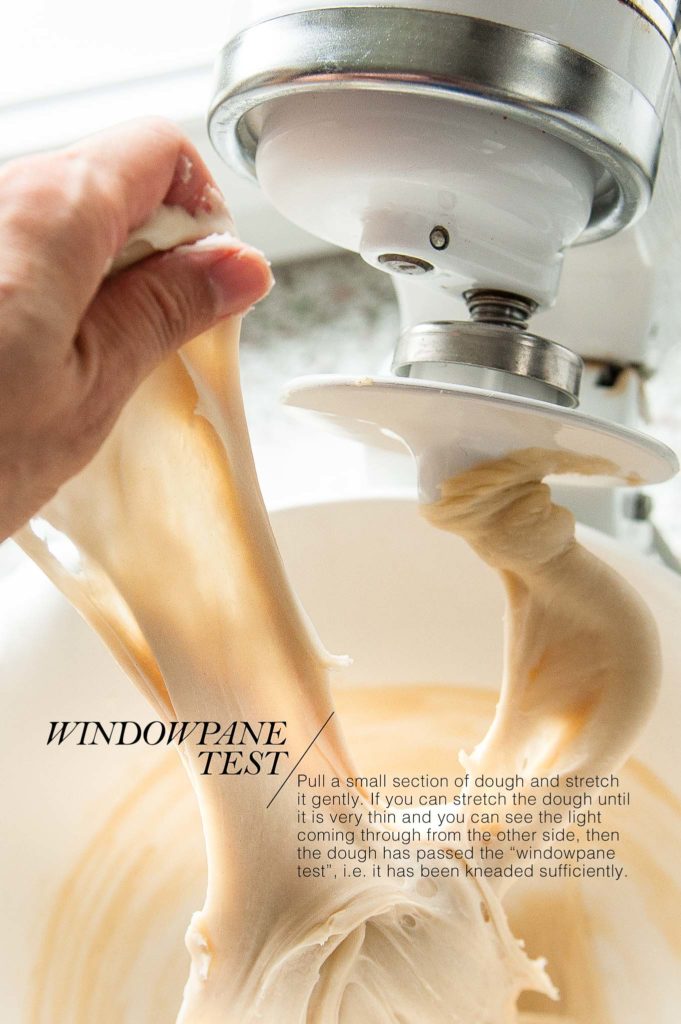
Step 5
Frivolously oil a big mixing bowl. Roll the dough right into a smooth-ish ball and place it contained in the bowl.
Cowl with a clear tea towel, and set it apart someplace heat for about 1 hour, or till it has doubled in dimension.
Step 6
As soon as the dough has doubled in dimension, gently take away the dough from the bowl. The dough will deflate as you deal with it.


Step 7
Divide the dough into 9 equal parts (I like to recommend utilizing a digital kitchen scale). Roll every portion right into a {smooth} ball. Place the balls of dough right into a sq. baking pan lined with baking paper.
Step 8
Cowl the pan with plastic wrap and go away it someplace heat for about half-hour, or till the buns have virtually doubled in dimension and are simply touching one another.


Step 9
Gently brush the buns with some egg wash, and bake for 20-25 minutes, or till the buns are frivolously golden.
If the buns are browning too shortly (test at 10-Quarter-hour), loosely cowl them with a sheet of foil for the remainder of the baking time.
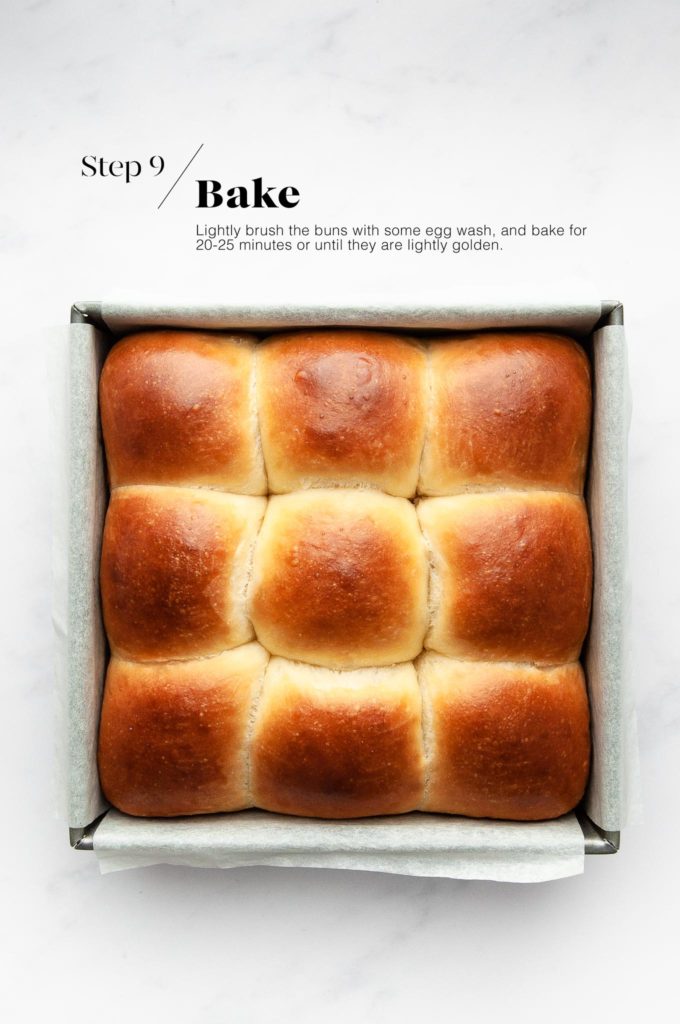
Variations and Ideas for Making Milk Buns
Relying on what you intend to serve with the Milk Buns, listed below are some concepts for making them further particular every time:
- Earlier than baking, sprinkle the buns with furikake, sea salt flakes, all the things bagel seasoning, sesame seeds, poppy seeds, fennel seeds … the concepts are countless!
- This recipe makes dinner roll-sized buns. For bigger buns, divide the dough into 6 items and bake in an oblong pan.
- Any leftovers ought to be saved in a ziplock freezer bag and stored in a cool place away from daylight. The buns ought to preserve properly for a number of days.

Ideas for Making Bread Dough Forward of Time
I really like baking bread, however I don’t love getting up further early to get began on the dough. So I usually make the dough the evening earlier than and permit it to rise slowly within the fridge in a single day. The longer proofing time has the additional advantage of permitting the dough to develop extra flavour and a greater texture. Come the morning, the dough could have not less than doubled in dimension, and it is going to be prepared for shaping as per the recipe.
To make the dough the evening earlier than:
- Make the dough as per the recipe.
- Place the dough into a big oiled bowl.
- Cowl the bowl with plastic wrap or a reusable bowl cowl.
- Place the bowl into the fridge.
- Let the dough rise in a single day, or for not less than 8-10 hours.
- The following morning, the dough ought to have not less than doubled in dimension.
- Gently take away the dough from the bowl.
- The dough is prepared for shaping and the second proof as per the recipe.
- Because the dough will likely be chilly from the fridge, the second proof might take barely longer.
Japanese Milk Buns
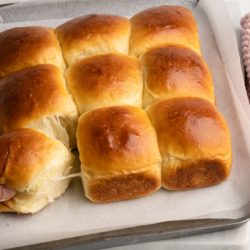
- Resting Time: 2 hours
- Prep Time: 30 minutes
- Cook dinner Time: 25 minutes
- Whole Time: 55 minutes
- Yield: Makes 9 buns
- Class: Bread
- Methodology: Oven
- Delicacies: Japanese
Strive these extremely gentle and fluffy bread rolls that are scrumptious served with a candy or savoury filling. Recipe for Milk Buns with step-by-step images.
Components
For the Tangzhong
- 2 tablespoons robust white bread flour
- 100 ml (1/3 cup plus 1 tablespoon) milk
For the Japanese Milk Bread Dough
- 350 g (2 1/3 cups) robust white bread flour
- 3 g (1 teaspoon) on the spot dried yeast
- 1 teaspoon advantageous salt
- 55 g (1/4 cup) caster sugar
- 1 egg
- 125 ml (1/2 cup) milk, warmed to 37°C/98°F
- 50 g (1/2 stick) unsalted butter, softened
For the Eggwash
Directions
For the Tangzhong
- Whisk the substances collectively in a small saucepan.
- Place the saucepan over low warmth.
- Maintain whisking till the substances kind a thick paste. The consistency ought to be thick sufficient in order that as you whisk the combination, the whisk leaves strains within the combination which stays.
- Take away the paste to a small bowl, and set it apart to chill down.
To Make the Dough
- Measure the flour, yeast, salt and sugar into the bowl of an electrical stand mixer.
- Combine the dry substances collectively utilizing a dough hook.
- Add the egg and the cooled Tangzhong.
- Slowly add the milk till the combination comes collectively right into a sticky dough.
- Add the butter, one tablespoon at a time. Look ahead to every tablespoon of butter to be absolutely included into the dough earlier than including the subsequent.
- Proceed kneading the dough on medium pace for about 10-Quarter-hour, or till the dough passes the windowpane check. (See Kitchen Notes under). By this stage, the dough must also be coming away from the edges of the bowl.
- Frivolously oil a big, clear mixing bowl.
- Roll the dough right into a {smooth} ball and place it into the blending bowl.
- Cowl the dough with a clear tea towel or bowl cowl, and place it someplace heat for about 1.5 hours, or till it has doubled in dimension.
Portion the Dough
- Gently take away the dough from the bowl. The dough will deflate as you deal with it.
- Divide the dough into 9 equal parts. Use a digital scale for even-sized buns.
Shaping the Dough
- Line a sq. baking pan with baking paper.
- Roll each bit of dough right into a {smooth} ball. I do that by pulling the perimeters of the dough into the centre, after which pinching these edges collectively whereas shaping the dough right into a {smooth} ball as you achieve this. The pinched edges kind the underside of the buns.
- Repeat the above steps with the remaining items of dough.
- Place the formed buns into the lined baking pan.
Proving the Formed Dough
- Place the pan someplace heat, coated with a clear tea towel, for about half-hour, or till the buns have virtually doubled in dimension and are touching one another within the pan.
Baking the Japanese Milk Buns
- Preheat the oven to 180°C/356°F (with out fan).
- Place a steel baking tray on the center shelf.
- Frivolously brush the buns with some egg wash.
- Bake the buns for about 20-25 minutes, or till they’re frivolously golden. Examine the buns at about 10-Quarter-hour and, if they’re browning too shortly, cowl the buns with a free sheet of foil for the remaining baking time.
- The buns are cooked if an inner thermometer reads 85°C/185°F.
- Depart the buns within the pan for about 5 minutes, earlier than rigorously eradicating the buns to a wire rack to chill fully.
Kitchen Notes
 WINDOWPANE TEST
WINDOWPANE TEST
Pinch off a small piece of dough, roll it right into a ball and use your palms to softly stretch the dough. If the dough can stretch to kind a skinny sheet and be virtually translucent with the intention to see the sunshine by it, your dough has handed the “windowpane check”. Which means that you could have kneaded the dough sufficiently and that the dough is able to be proofed.
 MAKE AHEAD TIPS
MAKE AHEAD TIPS
To begin the Milk Bread dough the evening earlier than, make the dough as per the recipe. Place the bowl of dough (coated) within the fridge to proof in a single day, or for not less than 8 to 10 hours. Throughout this time, it ought to have not less than doubled in dimension. The following day, proceed with the remainder of the recipe. Because the dough will likely be chilly, it might require a bit extra time for the second proofing interval.
 DIFFERENT TYPES OF FLOUR
DIFFERENT TYPES OF FLOUR
* For Swiss readers: I take advantage of Zopfmehl (or farine pour tresse) when making bread and enriched dough.
 DIFFERENT TYPES OF YEAST
DIFFERENT TYPES OF YEAST
* Please observe that there’s a distinction between on the spot yeast (additionally known as on the spot dried yeast or fast-action dried yeast) and dried yeast (additionally known as lively dry yeast). If you’re undecided what kind of yeast you could have, please test the packaging for directions on the way to use the yeast.
* With on the spot yeast, you may add it on to the flour combination with out having to activate it first.
* With dried yeast, you’ll need to activate it first (normally in some heat liquid).
 PROOFING THE DOUGH
PROOFING THE DOUGH
Dough wants a heat surroundings for the yeast to activate and trigger the dough to rise. In case you don’t have a heat place in your house, attempt one of many following concepts:
* Within the oven with the oven mild switched on (works just for some ovens).
* Within the oven with a tray of boiling water on the underside shelf.
* Within the oven at a low temperature of about 25-30°C (77-86°F).
 OVEN TEMPERATURES
OVEN TEMPERATURES
All recipes on this web site state temperatures for a daily oven (i.e. a standard oven with out fan). In case you have a convection oven with a fan, please seek the advice of the producer’s handbook on the way to alter the temperature and baking time accordingly.
 CONVERSIONS
CONVERSIONS
To transform from cups to grams, and vice-versa, please see this helpful Conversion Chart for Fundamental Components.

